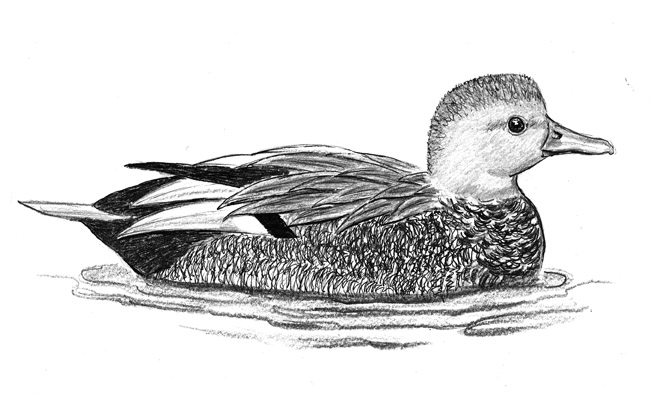
Dear Bird Folks,
A few weeks ago you mentioned something about a bland duck called a “Gadwall.” You also said that you weren’t sure if you had ever written about Gadwalls before. Well, I checked into it and you are right, you haven’t written a column about them. Since I like bland things, could you please pass on some information about Gadwalls?
– Tim, Sandwich, MA
Swell, Tim,
There’s nothing like a lengthy newspaper column about a bland duck to get the New Year off to a snoring start. You are about to find out that I wasn’t kidding – Gadwalls really are bland birds. But don’t worry; I’ll do it. After all, I was raised on Irish food so bland doesn’t bother me one bit. But what I’m wondering about is, how were you able to find out that I haven’t written about Gadwalls before? Even I wasn’t sure. Do you have connections at the NSA or work for CSI: Ask the Bird Folks? Maybe I should give you a call the next time I can’t remember any one of my 200,000 passwords, which happens about ten times a day.
Nearly thirty different species of ducks are regularly seen here on Cape Cod, and a few of these ducks look quite spectacular. Harlequin Ducks, King Eiders and Wood Ducks almost defy description. Pintails and Long-tailed Ducks, as their names imply, have super-long plumes that stick out of their a…aft sections. Even the Buffleheads, in their simple black and white outfits, have personalities that make them far more colorful than they really are. Then there are ducks that have no special coloration, or flashy tail feathers or notable personalities. These are the Gadwalls. Gadwalls are dabbling ducks, which means they are too lazy to dive for food. They only eat what they can find above or just below the water’s surface. In terms of coloring, they are mostly gray and from a distance look like a cross between a fog bank and a suit worn by an insurance agent. Don’t get me wrong, I like Gadwalls; they just aren’t all that interesting. I’m sure some other folks will disagree. In fact, one of my best birding buddies loves them, but then again her husband sells insurance, so…
How the Gadwall got its name makes for an interesting story. No, wait, it doesn’t. Actually, we don’t know where their name came from and nobody has ever looked into it (probably due to lack of interest). The bulk of North America’s Gadwall population breeds in the northern prairies, in areas known as “prairie potholes.” Much like the Cape’s kettle ponds, prairie potholes are shallow ponds or wetlands that were formed by the glaciers. The prairie potholes are critical for waterfowl, and it is estimated that half of North America’s ducks come from this region. Unfortunately, 50% of the prairie potholes have been filled in for agriculture and development. (It’s too bad the prairie potholes weren’t here in Massachusetts, because this state hasn’t filled a pothole in years.)
When we think of a duck’s voice we imagine a boisterous “quack” sound. But producing loud quacks would be too much effort for a Gadwall. Instead, the male Gadwall produces a quiet “burp” noise. Ordinarily, a bird that burped would be cool and might likely be the hero of every boy in middle school in the country. But the drake Gadwall’s burp is too soft. It ends up sounding more like a muffled frog (or the snoring coming from someone who is reading this dull column). But what Gadwalls lack in flash and excitement, they make up for with their intelligent nesting skills.
Predators habitually raid duck nests, so the clever Gadwalls build their nests on small islands or in heavy vegetation. This helps to keep their ducklings safe from hungry raccoons and foxes. Speaking of vegetation, egg production consumes a lot of the female’s energy. During this time period she will augment her diet with extra animal matter (snails, water bugs, etc.). Throughout the rest of the year, however, Gadwalls are basically vegetarians. Vegetarians, eh? Maybe Gadwalls are better ducks than I’ve been giving them credit for. I may have to rethink this whole thing. Since the bulk of the Gadwall population breeds in the northern prairies, you might expect them to be rare visitors to Cape Cod, and for many years this was the case. Then someone decided that Massachusetts had decent Gadwall habitat (and not just because we don’t fill in our potholes). So in 1971, Gadwalls were introduced to Great Meadows National Wildlife Refuge in Concord and to Felix Neck Wildlife Sanctuary on Martha’s Vineyard. As result, Gadwalls now breed at several locations throughout the state, including our very own Monomoy Wildlife Refuge. Ironically, Gadwalls no longer breed on Martha’s Vineyard, but have moved across the Sound to neighboring Nantucket. Apparently, the ducks got tired of dealing with the endless stream of U.S. Presidents playing golf on the Vineyard each summer, and who can blame them?
I hope you understand, Tim, that I wasn’t being totally serious in my complaints about Gadwalls. While they certainly aren’t the most vibrant duck, their understated coloration is perhaps their ultimate charm. After all, we like titmice and catbirds and they aren’t flashy. And some people, including my birding friend, really like them. Heck, some folks are even attracted to insurance agents. That’s the one I don’t understand.